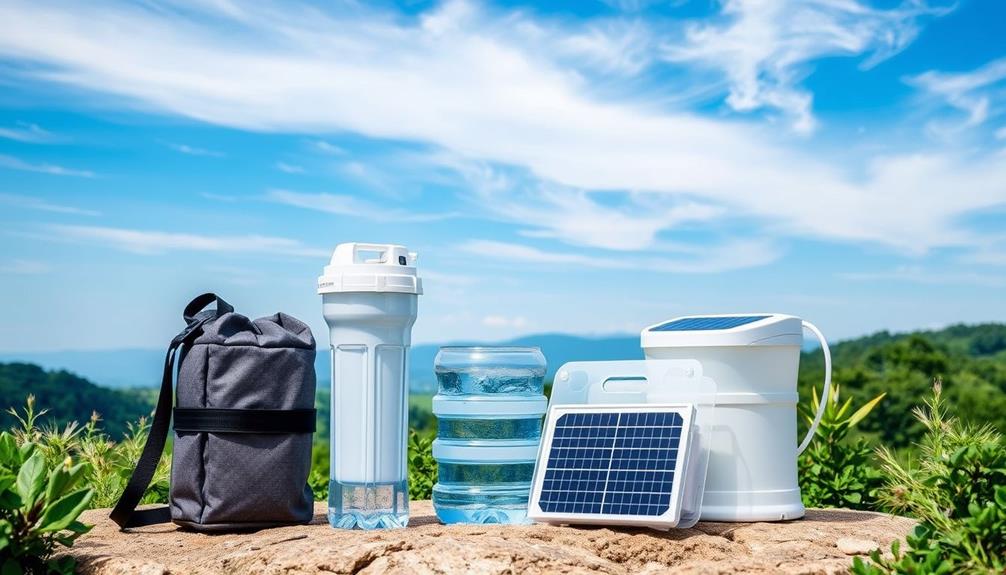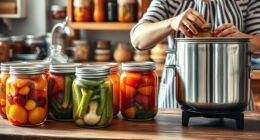To avoid going hungry during a digital blackout, start by preparing ahead. Assess your fridge and stock up on nonperishable items like canned beans and pasta. Cook perishables in advance and plan meals that combine both types for balanced nutrition. Keep fridge doors closed to maintain temperature and regularly check thermometer levels. Don't forget to involve your family in meal prep for teamwork. Easy no-cook meal ideas like chunky gazpacho or tuna tacos can save time and energy. Want to learn more essential tips to keep your family well-fed during outages? Explore options that suit your needs. If you’re dealing with a digital blackout, staying informed without internet can be a challenge. Keep a battery-powered radio on hand to stay updated on any emergency information or news. Consider subscribing to a local alert system that can send updates via text message or phone call. Being prepared and staying informed are crucial during any outage, and taking proactive steps can help ensure the well-being of your family.
Key Takeaways
- Assess and prioritize perishables beforehand to minimize spoilage during outages.
- Stock up on nonperishable items like canned goods and grains for emergency meals.
- Plan meals around available ingredients to reduce food waste during power disruptions.
- Utilize frozen water bags and ice packs to keep perishables cool longer.
Pre-Outage Preparation
Before a power outage hits, you need to assess your fridge and freezer contents to prioritize using perishables like meat, eggs, and dairy. Take a good look at what you have and identify items that are at risk of spoiling. Plan to cook and consume these perishables first to minimize food waste during the outage.
To further prepare, consider cooking up your favorite frozen items in advance. This proactive step guarantees you enjoy them while they're still fresh, and it cuts down on what could go bad later. Also, freeze bags of water; they'll serve as additional cooling sources and ice packs, helping to keep perishables cold longer in a cooler.
Don't forget to stock up on nonperishable items, like canned beans, tuna, and pasta. These will be your go-to supplies when power outages strike.
Meal Planning Strategies

How can you effectively plan meals to make the most of both perishable and nonperishable items during a digital blackout? Start by evaluating what you have in your pantry and fridge. Focus on meal planning that combines nonperishable items, like canned goods and grains, with perishable items to maximize usage and minimize waste.
Consider this simple meal plan:
| Day | Meal | Key Ingredients |
|---|---|---|
| Monday | Canned Soup & Bread | Canned soup, bread |
| Tuesday | Rice & Beans | Rice, canned beans, spices |
| Wednesday | Stir-Fried Veggies | Fresh veggies, leftover rice |
| Thursday | Pasta with Tomato Sauce | Pasta, canned tomatoes |
| Friday | Omelet with Leftovers | Eggs, leftover veggies |
Cook larger portions on certain days to create leftovers, making it easier to reheat meals later in the week. This strategy not only saves time but also helps you avoid last-minute grocery trips. By planning ahead, you can enjoy a variety of meals and guarantee your family stays fed, even during a blackout.
Food Safety Guidelines

Maintaining food safety during a digital blackout is crucial to prevent spoilage and reduce the risk of foodborne illnesses. Here are some key food safety tips to keep in mind:
- Keep the fridge and freezer doors closed: This helps uphold a safe temperature. Your refrigerator will stay cold for about four hours, while a full freezer can keep food safe for around 48 hours if unopened.
- Monitor perishables like meat: If food has been above 40°F for more than two hours, you should discard it. This includes raw meat, eggs, and leafy greens, as they can lead to foodborne illnesses.
- Use an appliance thermometer: Regularly check your refrigerator and freezer temperatures to confirm they stay at safe levels. This can help you minimize waste and keep your family safe during a power disruption.
Cleanup and Convenience

When a digital blackout hits, having the right cleanup strategies can make all the difference.
You can simplify post-meal tasks with disposable dinnerware and easy-to-clean alternatives, keeping stress levels low.
Plus, smart meal prep will help you stay organized and ready, ensuring a smoother experience for everyone involved.
Disposable Dinnerware Benefits
Using disposable dinnerware during a digital blackout simplifies cleanup and enhances convenience, letting you focus more on enjoying meals with your family. Here are three key benefits to take into account:
- Quick Cleanup: With disposable dinnerware, you can skip the washing and scrubbing. After your meal, simply toss the items in the trash or compost bin, saving you time and effort during emergencies.
- Food Safety: Disposable plates and utensils minimize the risk of cross-contamination, which is vital when power outages can make food safety a top concern. You can feel confident that your family is eating safely.
- Eco-Friendly Options: Many disposable dinnerware products are made from biodegradable materials, making it easier to align your meal prep with sustainability goals while still providing the convenience you need.
In these challenging times, using disposable dinnerware not only reduces stress but also creates a more relaxed dining atmosphere.
Easy-to-Clean Alternatives
Disposable dinnerware isn't the only way to simplify cleanup during a digital blackout; exploring easy-to-clean alternatives can enhance your convenience even further.
Consider using aluminum foil pans for cooking and serving meals. They're disposable, so you can just toss them after use, drastically reducing post-meal cleanup time.
Prepare a cooler with ice packs or frozen water bags to keep your perishable items organized and easily accessible. This minimizes the mess you'd deal with when rummaging through regular storage.
Opt for recipes that require minimal cooking or even no-cook meal ideas. These choices not only keep your meal prep simple but also limit the number of dirty dishes generated.
Engage your family members by assigning them specific tasks during meal preparation, which can make the experience fun while reducing clutter and dishes left behind.
Meal Prep Strategies
To streamline meal prep during a digital blackout, focus on strategies that minimize cleanup and enhance convenience. Here are three key tips:
- Use Disposable Plates: Opt for disposable plates, utensils, and cups to cut down on post-meal cleanup. This keeps your kitchen organized and lets you spend more quality time with family members.
- Prepare Minimal Cooking Meals: Plan meals that require minimal cooking, such as salads, sandwiches, or meals in aluminum foil pans. These options reduce the need for additional dishes while providing satisfying options for everyone.
- Keep a Cooler Handy: Use a cooler to store perishables and organize food effectively. This makes it easier to access items and reduces clutter, allowing you to focus on meal prep rather than searching for ingredients.
Family Engagement

Get your family involved in meal planning by brainstorming creative recipes together, making it a fun and engaging experience.
Turn cooking into a team effort where everyone has a role, helping to build skills and reduce stress.
This digital blackout is the perfect chance to explore new flavors and techniques as a family.
Collaborative Meal Planning
Engaging every family member in meal planning not only fosters collaboration but also assures that everyone's dietary preferences and needs are thoughtfully considered. By involving everyone, you create an inclusive atmosphere that encourages creative ideas and guarantees balanced meals.
Here are three effective strategies to enhance your family's meal planning:
- Family Recipe Treasure Hunt: Immerse yourselves in cookbooks or online resources together. Search for recipes that utilize available nonperishable items and make meal planning exciting.
- Teach Food Management: Educate your children about food safety, emphasizing the importance of using perishables first during a power outage. This knowledge empowers them and promotes responsibility.
- Set a Family Cooking Day: Allocate time for a fun family cooking session where everyone contributes. This hands-on experience not only strengthens bonds but also reinforces the importance of teamwork in meal preparation.
Fun Cooking Activities
Creating fun cooking activities can turn meal preparation into an enjoyable family event, sparking creativity and teamwork in the kitchen. Start by involving everyone in meal planning, making a list of recipes that utilize your non-perishable items. This not only encourages family bonding but also minimizes food waste.
You can organize a recipe treasure hunt where you hide ingredients or recipe cards around the house, transforming the task into an exciting game. Encourage culinary creativity by allowing each family member to invent a dish using available ingredients. This fosters ownership and excitement in cooking.
Use cooking sessions as teaching moments to educate your children about food safety and the importance of nutrition. Assign specific roles—like chopping, mixing, or setting the table—to create a sense of teamwork and shared responsibility.
Here's a table to highlight these fun cooking activities:
| Activity | Benefits |
|---|---|
| Collaborative Meal Planning | Enhances teamwork, reduces waste |
| Recipe Treasure Hunt | Engages kids, teaches management |
| Create Your Own Dish | Boosts creativity and ownership |
| Food Safety Lesson | Instills knowledge & safety |
| Role Assignment | Encourages responsibility |
Let the fun begin!
Easy No-Cook Meal Ideas

No-cook meals can be quick, nutritious, and satisfying, making them perfect for a digital blackout. You don't have to worry about complicated recipes or heating things up. Here are three easy no-cook meal ideas that will keep your family fed:
- Chunky Gazpacho: Combine canned diced tomatoes, chopped onions, and cucumbers. Add your favorite spices and drizzle with olive oil for a revitalizing lunch.
- Corn Salad: Mix drained canned corn with fresh chopped veggies like bell peppers and red onion. Dress it with apple cider vinegar and olive oil for a vibrant side.
- Tuna Tacos: Use canned tuna mixed with avocado, diced tomatoes, and cucumbers. Serve in taco shells or tortillas for a quick and tasty dinner.
For breakfast, you can whip up overnight oats by mixing rolled oats and water, then adding peanut butter or fruits and veggies in the morning.
These easy no-cook meals aren't only simple but also packed with flavor and nutrition, ensuring your family stays satisfied during a blackout.
Food Longevity During Outages

Understanding how to keep food safe during outages is essential for minimizing waste and ensuring your family's nutrition. When the power goes out, knowing how long your food will last can help you make informed decisions.
| Food Type | Duration Safe Below 40°F |
|---|---|
| Refrigerator | 4 hours |
| Full Freezer | 48 hours |
| Half-Full Freezer | 24 hours |
| Insulated Cooler (with ice) | Up to 5 days |
| Room Temperature Foods | Indefinite (if stored properly) |
To maximize food longevity, keep your refrigerator and freezer doors closed. Room temperature foods like bread, butter, and fresh fruits are safe to eat even after a power loss. Raw fresh foods, such as apples and avocados, can last for days without refrigeration, providing nutritious options.
Be cautious with perishables; if food has been above 40°F for over 2 hours, it should be discarded to prevent foodborne illness. Using an insulated cooler with ice packs or dry ice during prolonged outages can further help keep your food safe and minimize waste.
Essential Foods to Stock Up On

Stocking up on essential non-perishable foods guarantees you have the nutrition you need during a digital blackout. These items aren't only shelf-stable but also packed with nutrients to keep your family healthy.
Here are three must-haves to include in your emergency supplies:
- Canned Beans: These are versatile, rich in protein, and can be added to various dishes for a hearty meal.
- Breakfast Cereal: Stock up on whole grain cereals for quick breakfasts that provide energy and essential nutrients. Pair it with peanut butter for an extra boost.
- Canned Salmon: This is a great source of omega-3 fatty acids and can be used in salads or sandwiches.
Don't forget to include whole grains, like pouches of fully cooked rice or quinoa, which can serve as a base for many meals.
Also, keep a supply of healthy snacks, such as whole-wheat crackers and nuts, to maintain energy levels throughout the day.
Conclusion
In the face of a digital blackout, you can turn a temporary inconvenience into a delightful opportunity for family bonding and creativity.
By prepping wisely and embracing the art of meal planning, you'll guarantee your loved ones stay nourished and engaged.
Remember, a little preparation goes a long way in transforming potential hunger pangs into memorable moments.
So, stock up, get creative, and enjoy the charm of simplicity while keeping your family well-fed and happy!










